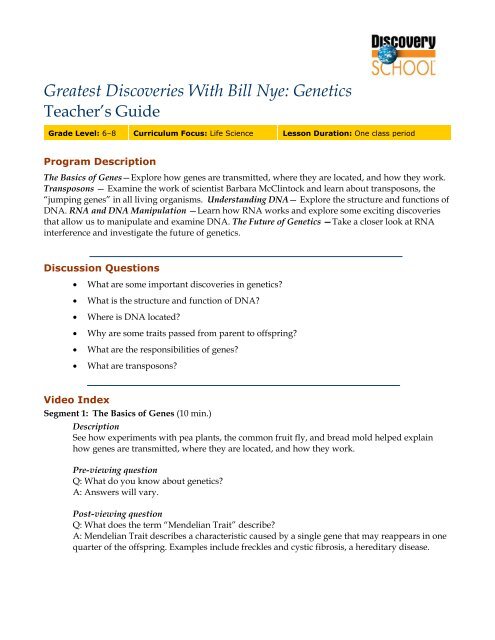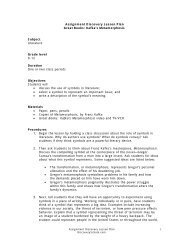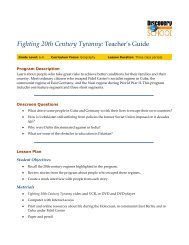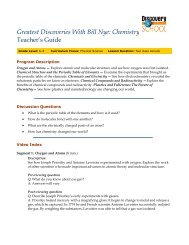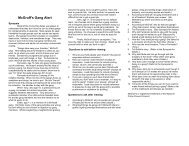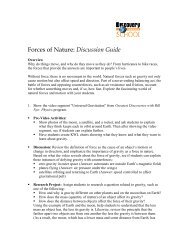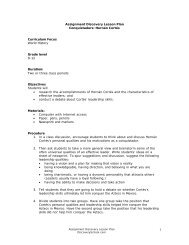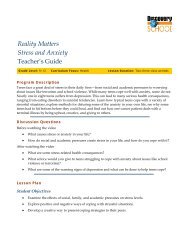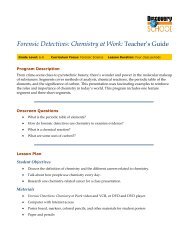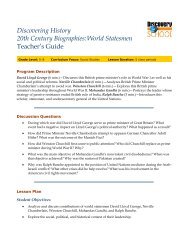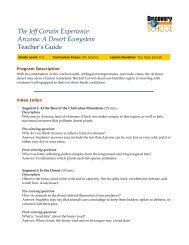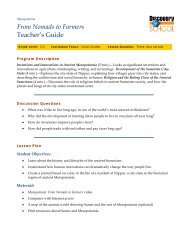Greatest Discoveries With Bill Nye: Genetics - Discovery Education
Greatest Discoveries With Bill Nye: Genetics - Discovery Education
Greatest Discoveries With Bill Nye: Genetics - Discovery Education
Create successful ePaper yourself
Turn your PDF publications into a flip-book with our unique Google optimized e-Paper software.
<strong>Greatest</strong> <strong>Discoveries</strong> <strong>With</strong> <strong>Bill</strong> <strong>Nye</strong>: <strong>Genetics</strong><br />
Teacher’s Guide<br />
Grade Level: 6–8 Curriculum Focus: Life Science Lesson Duration: One class period<br />
Program Description<br />
The Basics of Genes—Explore how genes are transmitted, where they are located, and how they work.<br />
Transposons — Examine the work of scientist Barbara McClintock and learn about transposons, the<br />
“jumping genes” in all living organisms. Understanding DNA— Explore the structure and functions of<br />
DNA. RNA and DNA Manipulation —Learn how RNA works and explore some exciting discoveries<br />
that allow us to manipulate and examine DNA. The Future of <strong>Genetics</strong> —Take a closer look at RNA<br />
interference and investigate the future of genetics.<br />
Discussion Questions<br />
• What are some important discoveries in genetics?<br />
• What is the structure and function of DNA?<br />
• Where is DNA located?<br />
• Why are some traits passed from parent to offspring?<br />
• What are the responsibilities of genes?<br />
• What are transposons?<br />
Video Index<br />
Segment 1: The Basics of Genes (10 min.)<br />
Description<br />
See how experiments with pea plants, the common fruit fly, and bread mold helped explain<br />
how genes are transmitted, where they are located, and how they work.<br />
Pre-viewing question<br />
Q: What do you know about genetics?<br />
A: Answers will vary.<br />
Post-viewing question<br />
Q: What does the term “Mendelian Trait” describe?<br />
A: Mendelian Trait describes a characteristic caused by a single gene that may reappears in one<br />
quarter of the offspring. Examples include freckles and cystic fibrosis, a hereditary disease.
<strong>Greatest</strong> <strong>Discoveries</strong> <strong>With</strong> <strong>Bill</strong> <strong>Nye</strong>: <strong>Genetics</strong><br />
Teacher’s Guide 2<br />
Segment 2: Transposons (5 min.)<br />
Description<br />
Before geneticist Barbara McClintock conducted her experiments, scientists thought genes were<br />
stable in their transmission. Learn about McClintock’s discovery of transposons, or jumping<br />
genes that exist in all living things.<br />
Pre-viewing question<br />
Q: What do you know about genetic mutations?<br />
A: Answers will vary.<br />
Post-viewing question<br />
Q: What are transposons?<br />
A: Found in the genes of all living things, transposons are sequences of DNA that move to<br />
different positions within the genome of a single cell. In a process known as transposition, they<br />
can move from one chromosome to another, causing genetic mutations. Transposons may be<br />
responsible for causing gene mutations in response to changes in an organism’s environment, a<br />
process that may have spurred the evolution of a species.<br />
Segment 3: Understanding DNA (6 min.)<br />
Description<br />
Explore how scientists Alfred Hershey, Martha Chase, James Watson, and Francis Crick<br />
discovered the functions and structure of DNA, the genetic material considered the blueprint of<br />
life.<br />
Pre-viewing question<br />
Q: What do you know about DNA?<br />
A: Answers will vary.<br />
Post-viewing question<br />
Q: Describe the structure of DNA.<br />
A: DNA is made of the four bases adenine, thymine, cytosine, and guanine, which are arranged<br />
in a double helix; the twin strands of the helix are composed of the four bases, linked together<br />
by hydrogen bonds. The whole structure resembles a spiral ladder and easily pulls apart to<br />
make copies of itself with the same genetic information.<br />
Segment 4: RNA and DNA Manipulation (14 min.)<br />
Description<br />
The discovery of messenger RNA revealed to scientists how DNA communicates instructions<br />
for making proteins. Learn how RNA works and explore discoveries that allow us to<br />
manipulate and compare DNA.<br />
Pre-viewing question<br />
Q: How is the study of genetics used outside of clinical research?<br />
A: Answers will vary.<br />
Published by <strong>Discovery</strong> <strong>Education</strong>. © 2005. All rights reserved.
<strong>Greatest</strong> <strong>Discoveries</strong> <strong>With</strong> <strong>Bill</strong> <strong>Nye</strong>: <strong>Genetics</strong><br />
Teacher’s Guide 3<br />
Post-viewing question<br />
Q: How does RNA work?<br />
A: RNA transmits instructions from DNA for making protein. Like DNA, RNA is made of four<br />
chemical bases. When three bases align in a sequence called a triplet, the triplet codes for a<br />
specific amino acid. The order of the triplets is the blueprint for the production of proteins, the<br />
genetic code. DNA is copied into RNA, and RNA contains the information that determines the<br />
sequence of amino acid and proteins.<br />
Segment 5: The Future of <strong>Genetics</strong> (7 min.)<br />
Description<br />
Examine a biological mechanism that holds great promise for the future, and take a look at<br />
a project that hopes to identify the functions of all the possible human genes.<br />
Pre-viewing question<br />
Q: What do you think will be some future applications of genetics?<br />
A: Answers will vary.<br />
Post-viewing question<br />
Q: What are the possible future applications for RNA interference?<br />
A: One application of RNA interference may be to understand it as a biological mechanism;<br />
another is using it as a tool to screen gene function; and a third might be to cure genetic<br />
diseases.<br />
Lesson Plan<br />
Student Objectives<br />
• Understand that DNA is responsible for inherited traits in living organisms.<br />
• Understand that each genetic trait is controlled by dominant and recessive genes.<br />
• Make Punnett squares.<br />
Materials<br />
• <strong>Greatest</strong> <strong>Discoveries</strong> <strong>With</strong> <strong>Bill</strong> <strong>Nye</strong>: <strong>Genetics</strong> program<br />
• Paper and pencils<br />
• Chalkboard or overhead projector<br />
• Computer with Internet access (optional)<br />
Procedures<br />
1. Hold a class discussion about different physical traits your students exhibit: straight and curly<br />
hair, blue and brown eyes, the ability to roll the tongue. Discuss DNA and explain that this is<br />
Published by <strong>Discovery</strong> <strong>Education</strong>. © 2005. All rights reserved.
<strong>Greatest</strong> <strong>Discoveries</strong> <strong>With</strong> <strong>Bill</strong> <strong>Nye</strong>: <strong>Genetics</strong><br />
Teacher’s Guide 4<br />
responsible for the traits that a living organism inherits from its parents. Some traits are passed<br />
through dominant and recessive genes. Introduce this topic by viewing <strong>Greatest</strong> <strong>Discoveries</strong> <strong>With</strong><br />
<strong>Bill</strong> <strong>Nye</strong>: <strong>Genetics</strong>.<br />
2. Talk about inherited traits and dominant and recessive genes. How do we know which traits a<br />
child will inherit from its parents? What examples of dominant and recessive genes were<br />
featured in the program?<br />
3. Explain to students that geneticists use a simple diagram, called a Punnett square, to predict the<br />
traits of offspring. Students will learn how to make and use such a diagram.<br />
4. Instruct students in making a simple monohybrid punnett square one isolated trait. First have<br />
them draw a large square on a piece of paper. Next they will divide this square into four equal<br />
sections. Draw the outline of a Punnett square on the board or overhead projector to illustrate<br />
that it should look like a windowpane.<br />
5. Tell students that scientists use two letters to represent a specific genotype in a Punnett square.<br />
Capital letters represent the dominant form of a gene, and lowercase letters represent the<br />
recessive gene. So, in the case of the eye color of fruit flies RR would represent red eyes, and rr<br />
would represent white eyes. Remind students to always use the same letters to represent both<br />
sides of a particular trait. Tell students to pretend they are attempting to determine the possible<br />
occurrence of white eyes in the offspring of one parent who has the RR genotype and one<br />
parent who has the rr genotype. Demonstrate making a Punnett square with these parents by<br />
doing the following:<br />
• Place the two letters of one parent on the top of the square (one letter above each<br />
column).<br />
• Place the two letters of the other parent on the side of the square (one letter on the side<br />
of each row).<br />
• Combine the letter above each column with the letter on the side of the row and fill the<br />
interior squares in with the resulting two letter combinations.<br />
6. Tell students that the two-letter combinations created in the square are the possible eye colors of<br />
the offspring. So the resulting letter combinations in the square will read Rr, Rr, Rr, and Rr. If R<br />
is the dominant form of the gene, any combination with R in it will result in red eyes because R<br />
is dominant and it overrides the recessive r. What are the chances that the offspring of these two<br />
parents will have red eyes? (Answer: 100 percent)<br />
7. Have students make a new Punnett square, this time using a parent fly with the dominant<br />
genotype Rr and a parent fly with the recessive genotype rr. The resulting two letter<br />
combinations should be Rr, Rr, rr, and rr. Will any of the offspring from these parents have<br />
white eyes? What percentage? (Answers: Yes and 50 percent)<br />
8. Once students understand how to make Punnett squares, have them create squares for their<br />
own possible offspring. Allow students to choose height, eye color, or hair texture for this<br />
Punnett square. Tell them that genetics can be complex, but for the sake of this lesson assume<br />
that:<br />
Published by <strong>Discovery</strong> <strong>Education</strong>. © 2005. All rights reserved.
<strong>Greatest</strong> <strong>Discoveries</strong> <strong>With</strong> <strong>Bill</strong> <strong>Nye</strong>: <strong>Genetics</strong><br />
Teacher’s Guide 5<br />
• Curly hair is dominant (HH or Hh) and straight hair is recessive (hh).<br />
• Brown eyes are dominant (EE or Ee) and blue eyes are recessive (ee).<br />
• Tall is dominant (TT or Tt) and short is recessive (tt).<br />
After students have chosen which trait to use in their square, tell them to think about this trait<br />
in both their parents so they can label their own genes for this exercise. If they have curly hair<br />
(dominant), do both of their parents? If not, tell them to assume that their genotype is Hh, not<br />
HH. If they have straight hair, their genotype is hh, so they don’t need to consider their parents’<br />
hair. The same goes for the other two traits.<br />
9. Have students make three squares, each one using themselves and one of three potential mates<br />
as parents; the three potential mates would be a person who has a purely dominant genotype<br />
(HH), a person who has both dominant and recessive alleles (Hh), and a person who has a<br />
purely recessive genotype (hh). Give students time to create all three Punnett squares, then<br />
hold a discussion. What are the possibilities that they will have offspring with the dominant<br />
trait in each of the cases? What are the percentages of offspring having the recessive trait in<br />
each of the cases?<br />
10. Ask volunteers to share the information they learned from making their Punnett squares. If time<br />
allows, students may visit the following Web sites to learn more about Punnett squares,<br />
genetics, and inherited traits:<br />
Assessment<br />
• http://library.thinkquest.org/18258/Punnettsquares.htm<br />
• http://anthro.palomar.edu/mendel/<br />
• http://www.biology.arizona.edu/human_bio/problem_sets/human_genetics/human_geneti<br />
cs.html<br />
• http://www.hhmi.org/biointeractive/dna/index.html<br />
Use the following three-point rubric to evaluate students’ work during this lesson.<br />
• 3 points: Students were highly engaged in class discussions; demonstrated a clear<br />
understanding that genes are responsible for certain characteristics and traits in offspring;<br />
and were able to make accurate Punnett squares and clearly identify the percentage of<br />
dominant and recessive traits in possible offspring.<br />
• 2 points: Students were engaged in class discussions; demonstrated a basic understanding<br />
that genes are responsible for certain characteristics and traits in offspring; and were able to<br />
make somewhat accurate Punnett squares and mostly identify the percentage of dominant<br />
and recessive traits in possible offspring.<br />
• 1 point: Students participated minimally in class discussions; were unable to demonstrate a<br />
basic understanding that genes are responsible for certain characteristics and traits in<br />
offspring; and made incomplete or inaccurate Punnett squares and were unable to identify<br />
the percentage of dominant and recessive traits in possible offspring.<br />
Published by <strong>Discovery</strong> <strong>Education</strong>. © 2005. All rights reserved.
<strong>Greatest</strong> <strong>Discoveries</strong> <strong>With</strong> <strong>Bill</strong> <strong>Nye</strong>: <strong>Genetics</strong><br />
Teacher’s Guide 6<br />
Vocabulary<br />
characteristic<br />
Definition: A distinguishing quality<br />
Context: A pair of factors determines each inherited characteristic.<br />
chromosomes<br />
Definition: Rod-shaped structures contained in a cell made up of a molecule of DNA threaded<br />
around proteins<br />
Context: In females, the gene responsible for red eyes on one of the X chromosomes might be<br />
overshadowing the gene for white eyes on the other chromosome.<br />
dominant<br />
Definition: Of, relating to, or being an allele that produces the same phenotypic effect whether<br />
inherited with a homozygous or heterozygous allele; exercising the most influence or control<br />
Context: Certain genes are dominant and others are recessive.<br />
enzymes<br />
Definition: Any of several complex proteins produced by cells that act as catalysts in specific<br />
biochemical reactions<br />
Context: Genes direct the production of enzymes.<br />
genes<br />
Definition: Basic, functional units of heredity, each occupying a specific place on a chromosome<br />
Context: In 1909 a Danish botanist coined the term “genes” to describe Mendel’s factors in<br />
inherited traits.<br />
heredity<br />
Definition: Genetic transmission of characteristics from parent to offspring<br />
Context: Fixed laws of nature govern heredity.<br />
Academic Standards<br />
National Academy of Sciences<br />
The National Academy of Sciences provides guidelines for teaching science in grades K–12 to promote<br />
scientific literacy. To view the standards, visit this Web site:<br />
http://books.nap.edu/html/nses/html/overview.html#content.<br />
This lesson plan addresses the following science standards:<br />
• Science as Inquiry: Understanding about scientific inquiry<br />
Published by <strong>Discovery</strong> <strong>Education</strong>. © 2005. All rights reserved.
<strong>Greatest</strong> <strong>Discoveries</strong> <strong>With</strong> <strong>Bill</strong> <strong>Nye</strong>: <strong>Genetics</strong><br />
Teacher’s Guide 7<br />
• Life Science: Reproduction and heredity; Molecular basis of heredity; Characteristics of<br />
organisms<br />
• Science and Technology: Understanding about science and technology<br />
• History and Nature of Science: History of science; Historical perspectives; Science as a<br />
human endeavor<br />
Mid-continent Research for <strong>Education</strong> and Learning (McREL)<br />
McREL's Content Knowledge: A Compendium of Standards and Benchmarks for K-12 <strong>Education</strong><br />
addresses 14 content areas. To view the standards and benchmarks, visit<br />
http://www.mcrel.org/compendium/browse.asp<br />
This lesson plan addresses the following national standards:<br />
• Science—Life Science: Understands the structure and functions of cells and organisms;<br />
Understands the principles of heredity and related concepts<br />
• Science—Nature of Science: Understands the nature of scientific knowledge; Understands<br />
the nature of scientific inquiry<br />
• Language Arts—Viewing: Uses viewing skills and strategies to understand and interpret<br />
visual media<br />
• Technology—Understands the relationships among science, technology, society, and the<br />
individual<br />
Support Materials<br />
Develop custom worksheets, educational puzzles, online quizzes, and more with the free teaching tools<br />
offered on the <strong>Discovery</strong>school.com Web site. Create and print support materials, or save them to a<br />
Custom Classroom account for future use. To learn more, visit<br />
• http://school.discovery.com/teachingtools/teachingtools.html<br />
Published by <strong>Discovery</strong> <strong>Education</strong>. © 2005. All rights reserved.


